1958 German Grand Prix race report: Brooks wins race tainted by tragedy as Collins killed
Vanwall's Tony Brooks claims the second full Grand Prix of his career; Ferrari driver Peter Collins crashes fatally whilst battling for the lead
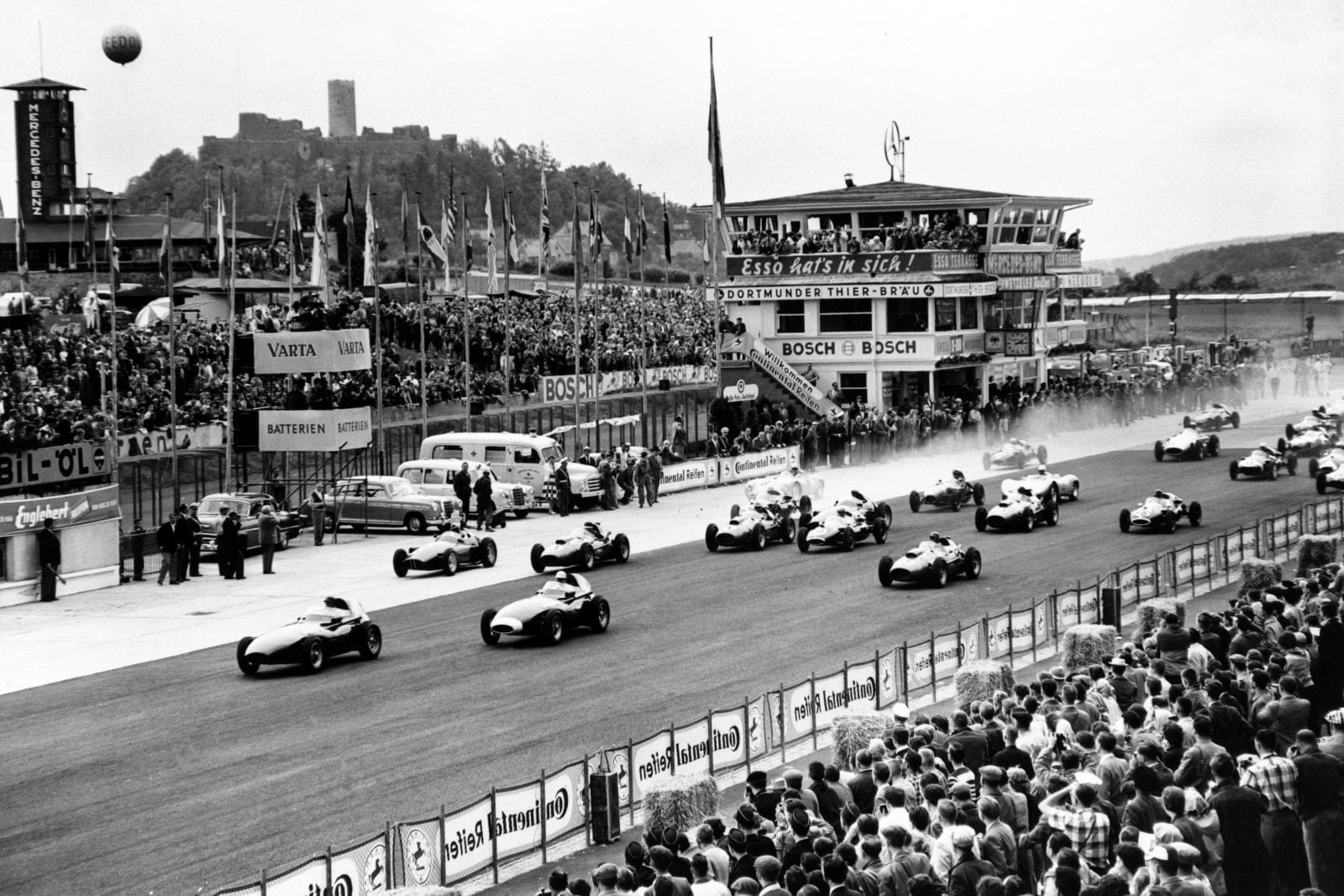
Cars on the grid at the start of the race.
Motorsport Images
In common with other organisers, the Automobile Club von Deutschland decided to reduce the German Grand Prix from its former powerful position down to a “milk-and-water” type of event by reducing the distance from 22 laps of the Nürburgring to 15 laps, a mere 342 kilometres, and as last year they ran a Formula II event in with the Grand Prix. To make the programme a “bumper one” they laid on a short sports-car and Gran Turismo car race in the morning before the main event.
The Scuderia Ferrari arrived midday on Thursday with three V6 Dino 246 Grand Prix cars, an experimental model and a Formula 2 car and, being early, they put in some unofficial practice that afternoon, this being the first time the Dino models had been to the Nürburgring. Hawthorn, von Trips and Phil Hill were there as drivers, the fourth member of the team, Collins, being due to arrive the next morning. The BRM team, the Vanwall team, Coopers, Lotus and Porsche all began arriving, so that when practice started on Friday afternoon there was plenty of activity.
The BRM team were making their first appearance at the formidable Eifel circuit and would have liked to have made some unofficial practice earlier but their drivers were not available, so they had to “find out,” just as Vanwalls had last year, though both Behra and Schell knew the circuit well, which helped a great deal.
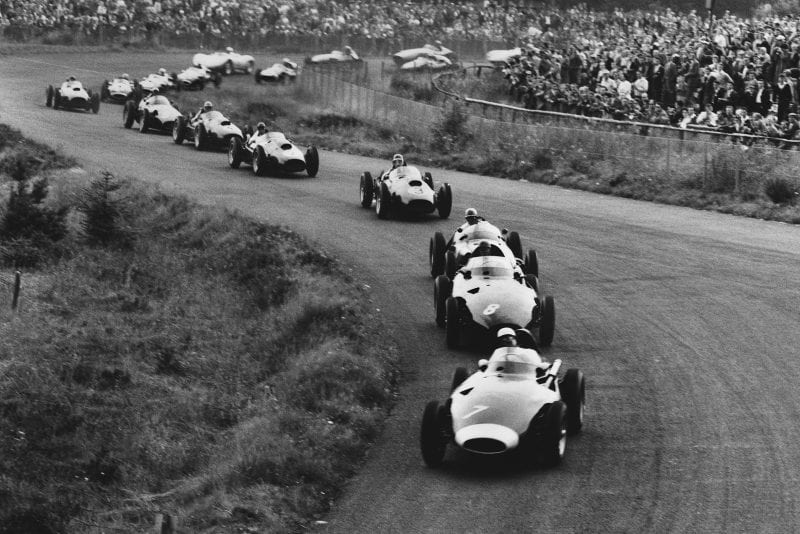
Stirling Moss driving a Vanwall leads Tony Brooks also in a Vanwall at the start of the race.
Motorsport Images
The Formula 1 Ferraris were driven by Hawthorn, Collins and von Trips, and the experimental car was tried by them as well, Hawthorn in particular being quite enthusiastic about its handling characteristics. The American driver Phil Hill was having his first single-seater Grand Prix drive with the Ferrari team, having been waiting a long time for it, and was given the Formula 2 car, an exact replica of the Formula 1 car apart from engine capacity and tyre sizes, though it had a lighter chassis frame with all the main longerons of the same diameter. It must not be overlooked, of course, that the present Formula 1 Ferraris were developed from the prototype Formula 2 car of last year.
The Vanwall team were much happier than last year, for they now knew more about the requirements regarding springs, shock-absorbers, anti-roll bars, steering geometry and so forth, since their debacle last year, but were in a sad state over engines, having destroyed one at Silverstone recently, and some more on the test-beds in preparation for this race, so that they could only bring three cars instead of their usual four, it not being possible to make new engines in a few days. As a result they entered only Moss and Brooks, with the third car as a spare, and Lewis-Evans did not have a drive.
“There was no sign of Fangio, he seemingly having retired from European racing”
Coopers entered Salvadori in their 2.2-litre car, and Trintignant was driving Rob Walker’s similar car, while Allison was in the 1958 Formula 1 Lotus, the horizontal engine position now being entirely abandoned.
There was a lone Maserati out on this first afternoon, it being Bonnier’s 1957 lightweight car he got from Scarlatti. Two other Maseratis were entered, these being the Centro-Sud cars, one for Troy Ruttman and the other for Hans Herrmann, but neither were ready for the first practice period. Of the 1958 ultra-lightweight works Maserati there was no sign, nor was there any sign of Fangio, he seemingly having retired from European racing, though at the time of the race he was still in Italy.
Qualifying
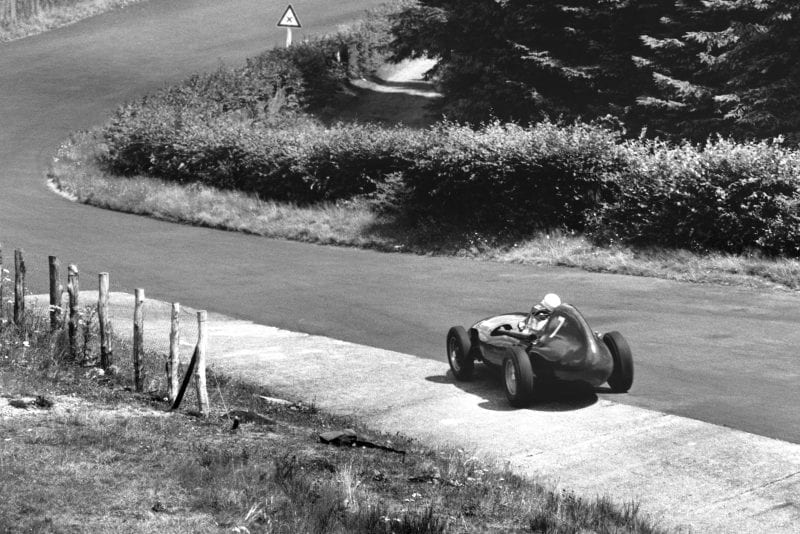
Stirling Moss’s Vanwall
Motorsport Image
Bearing in mind that since Fangio’s remarkable lap in 9min 17.4sec last year the circuit has been resurfaced in places and some of the corners eased and banked slightly, one could assume that his time would be approached and possibly beaten, most probably by a Ferrari, for the small Dino cars would be very manageable round the twists and turns of the Eifel circuit.
Having seen Moss go round in 9min 25sec with the 1958 Maserati back in June during some unofficial practice, there was every reason to suppose that this year’s Grand Prix cars should approach the lap record. Last year Hawthorn did 9min 24sec with the old cumbersome Lancia/Ferrari V8, so it was no surprise when he turned 9min 21.9sec with this year’s car, and both Collins and von Trips got below 9min 30sec quite easily. When Moss did likewise with the Vanwall it was clear that they had profited from last year’s experience, but BRM were in a sorry state, the cars being off the ground more than they were on it.
After some juggling with anti-roll bars, shock-absorbers and tyre pressures, and the cars being fitted with steering dampers and bracing struts to the tops of the king-pins, the Vanwalls were really finding their feet on the Nürburgring, and towards the end of the afternoon Moss stirred things up with a lap in 9min 19.9sec, to beat all three Ferraris. It was interesting that Bonnier was driving Maserati number 2529, the actual car in which Fangio set up his record lap last year, though, of course, the engine was no longer the same, last year’s car being on alcohol, and the Swedish driver put in a lap this year in 9min 42.7sec, a creditable time until one remembers last year’s race. Allison did 9 min. 44.3 sec, in the 1958 Lotus, which was indeed a worthy effort, it being the first visit to the Nürburgring of both driver and car.
In the Formula 2 category Brabham was worrying everybody by lapping in 9min 43.4sec with the works Cooper, this being the Formula 1 chassis that Salvadori had driven 80 well at Silverstone, now fitted with a 1,500cc Climax engine. The next best was Phil Hill with 9min 59.0sec in the little Ferrari, and after that no one could approach 10min. Porsche were very worried because they could not find a driver for their fast single-seater RSK that won at Reims. Behra being in the Formula I race and Barth not being too sure about passing a medical examination after his crash at the Freiburg hill-climb.
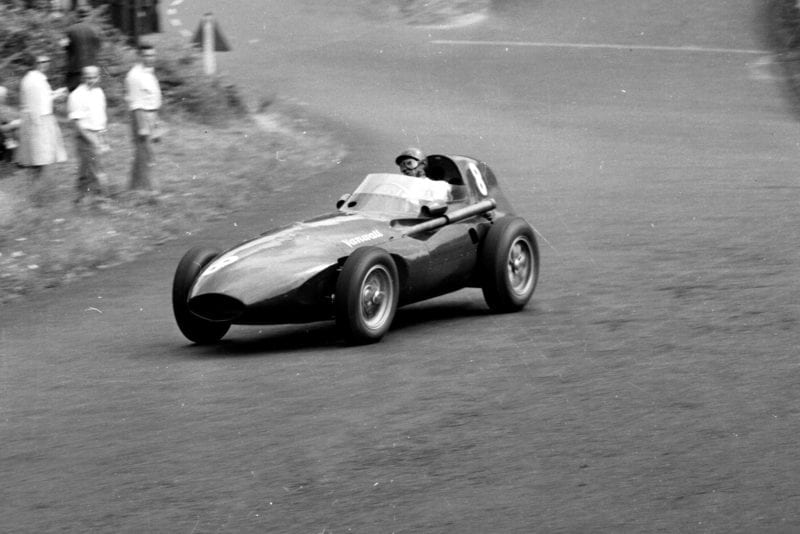
Tony Brooks driving his Vanwall.
Motorsport Images
As Lewis-Evans was standing around doing nothing he was loaned a sports Porsche to get in some practice, with a view to taking over the Formula 2 car if Barth could not drive. A single works Lotus was entered, this being a 1958 car with the engine in a near-vertical position, but a lot of the practice time was spent fitting Graham Hill into the driving seat and finding room for his feet around the clutch housing. Burgess was driving the Atkins Cooper, McLaren a works-supported one, Seidel was in Rob Walker’s 1957 Cooper, and Naylor, Gibson and Goethals had their own Surbiton-built cars, while Bueb had his 1957-type single-seater Lotus.
“A veritable tornado swept across the Eifel mountains, tearing down trees and flags and advertising, flooding everywhere around the paddock”
The Ferrari drivers were trying quite hard but could not make any impression on the Vanwall time that Moss had set up, though they were all ahead of Brooks, his car still having some further modifications to be made to it. Poor Behra was most unhappy as he lost control of his BRM and spun off into the undergrowth, bending the chassis slightly, and all in an endeavour to go as fast as Allison with the Lotus F1 and Brabham with the Cooper F2. Although the weather had been fair for the Grand Prix practice, apart from a very brief shower of rain, as soon as it was all over a veritable tornado swept across the Eifel mountains, tearing down trees and flags and advertising, flooding everywhere around the paddock, so that the day’s activities finished on a rather depressing note.
On Saturday, at midday, conditions were first class, with the track dry and clouds obscuring the sun occasionally to prevent things getting too hot. Behra was given the spare BRM and Brooks had his car fitted with a de Dion tube giving vertical wheel-positions instead of the usual positive-camber set-up, while Ferraris were trying some different shock-absorbers on their small car. Hawthorn was going immensely fast no matter where he was watched round the circuit, and he recorded an unbelievably quick lap in 9min 14.0sec, while Collins got down to 9min 21.9sec, taking most of his corners in full-opposite lock slides, seemingly just for the sheer fun of it, for it was obviously wasting some time.
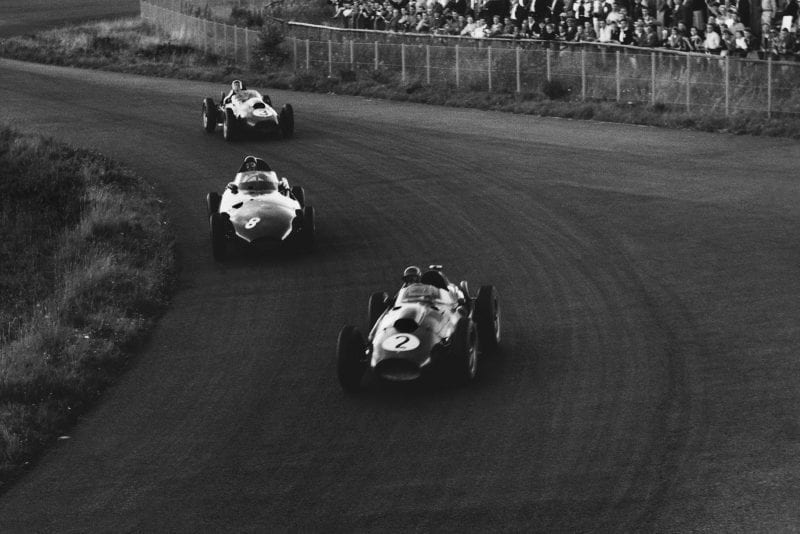
Peter Collins in his Ferarri Dino 246 leads Tony Brooks in a Vanwall and Mike Hawthorn in his Ferrari Dino 246.
Motorsport Images
In complete contrast to last year, Moss and Brooks were looking very comfortable and smooth, and though the former did not improve on the day before’s time, the latter got within 1sec of Hawthorn’s remarkable lap, and, watching the Vanwall go down the steep Fuchsröhre and through the following bends, the lap time was not surprising.
The two Centro-Sud Maseratis were in trouble right from the start, for Ruttman’s car burnt a hole in a piston almost before he had started to practise and Herrman’s car broke a half-shaft, while Bonnier was also in trouble with a broken valve. Both Salvadori and Trintignant were now going very well, and were approaching times of 9min 35sec and were faster than the BRMs but unable to approach the really fast cars, though Brabham was going round in a spare 2-litre car and lapping under 9min 30sec.
In Formula 2 the works Lotus was out, but had not gone far before the engine tightened up as Graham Hill was going into a corner and he spun onto the bank. After taking the engine to bits it was found that the Climax water-pump drive had sheared. As Hill had not done any serious practice he borrowed Allison’s Formula car and set off, but came back “cap in hand” having spun it and crumpled the front, so the Lotus team had to get busy with welding plant and hammer, while Allison was most philosophical about it and grinned, saying, “silly –––––”.
Among the Formula II drivers, McLaren was outstanding to watch on certain parts of the circuit and he was showing all the “press on” characteristics of Jack Brabham, and he got down to a time of 9min 56sec. Last year none of the Formula 2 cars could get below 10 min, though earlier this year, on the improved circuit, Behra did 9min 53.9sec with a 1,500cc sports Porsche during the 1,000-kilometre race, so that we had some form of yardstick to go by.
Phil Hill improved his time to 9min 48.9sec, but still could not look at Brabham’s remarkable time, and Collins had a go in the little Ferrari, but the Cooper was still fastest. Lewis-Evans went home as Barth turned up and took the F2 Porsche from him, and de Beaufort decided to run his 1500RS as a F2 as well as a sports car.
Marsh was going splendidly in his own Cooper, being noticeably fast up the climbing bit through the Karussel to Hohe Acht, which is real hill-climb stuff, and his time of 9min 57.5sec was only three-tenths of a second behind Barth’s best with the works Porsche. Bueb just failed to break 10min with his Lotus and the rest of the runners varied from slow to pathetic.
Saturday afternoon saw an immense amount of activity in the paddock, the Ferrari mechanics taking the engine from the experimental car and fitting it into the Collins car, and changing the ribbed alloy brake drums on the front of the Formula II car for normal cast-iron ones. Lotus mechanics were straightening out the Formula I car with the aid of the wonderfully-equipped service vans provided by the various petrol companies, which are a feature of German races, and BRM were trying to sort out their suspension problems. Vanwalls were fairly happy, doing routine maintenance and checking everything, and, in complete contrast, all three Maseratis were spread all over the floor. The Coopers were all free from any serious bothers, though Porsches were taking gearboxes apart and altering gears.
Before the Grand Prix began a 6-lap sports-car race took place, and mixed in with it was a Grand Turismo race for 1,600cc cars and 1,300cc cars, the former group being composed entirely of Porsche Carreras and 1600 Supers and the latter of Alfa-Romeo Sprint Veloce Giuliettas. The sports-car race itself was on interesting open battle between Borgward and Porsche, with Herrmann, Bonnier and Juttner driving the 1500RS from the Bremen factory and Behra and Barth driving for Stuttgart. In addition to these two German teams there was a factory Lotus Fifteen driven by Allison, a private Lotus Fifteen of Berchem, Piper’s 1,100cc car, and that promising American driver Dan Gurney with an Osca from the Centro-Sud stable.
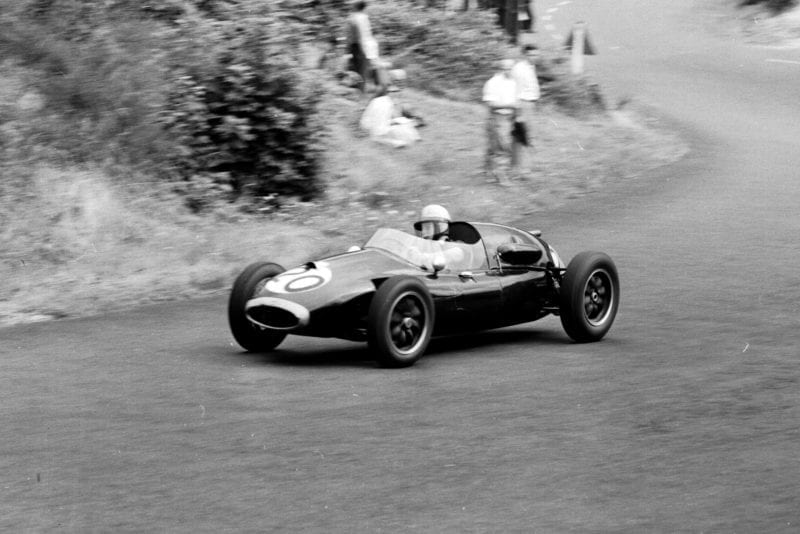
Bruce McLaren driving a Cooper T45-Climax
Motorsport Images
There was a certain amount of umbrage among some of the Porsche Gran Tourismo drivers for the A.v.D. decided not to allow any competition exhaust systems on the Carreras, even though they are accepted everywhere else, so, as a result, many of the Carreras were transferred to the sports category. From a spectator viewpoint this one-make GT racing is not exactly a technical exercise but it is a good proving ground to weigh up driver-ability. The five fastest times among the sports cars in practice had been Behra, Herrmann, Barth, Bonnier and Allison, the first fives all being under 10 min.
Behra was credited with 9min 39.0sec, faster than Brabham’s Formula 2 time, but though given officially it was very suspect. This suspicion was justified during the race, for Behra was credited with 9min 34.2sec yet Bonnier had lost only a few yards on the Porsche and Allison only 2 sec, and the Borgward and Lotus were lapping a little above 9min 50sec. Later Behra’s time was amended to 9min 48.9sec for the race lap record, which made sense, and nevertheless was very creditable, so one can assume that his practice time was 9min 49.0sec and not 39.0sec.
Although Behra led for the whole six laps, Bonnier hung on grimly, showing that the Borgward (described in the July issue of Motor Sport) was more than an equal for the RSK Porsche. Although Barth was in third place on the opening lap, Cliff Allison was driving brilliantly and swept the Lotus Fifteen round, caught the Porsche and held third place for four and a half laps, at last breaking up the German monopoly of the 1,500cc class on the Nürburgring.
However, it was too good to last and halfway round the sixth lap a rear radius-arm mounting broke away from the chassis and Allison came to rest, losing an honourable third place, so that the German monopoly took hold again. However, the Porsche monopoly was sadly disrupted, with Borgward’s second (Bonnier), fourth (Herrmann) and sixth (Juttner). Among the Gran Turismo cars everything went according to form, Schulze winning the Giulietta group from the Swiss driver Stern, who has been showing excellent promise this season, while among the Carreras the fastest was Walter, who makes a habit of going well in a Porsche, and the first 1600 Super was driven by Mahle, who made himself known last year by his driving of a Giulietta.
Race
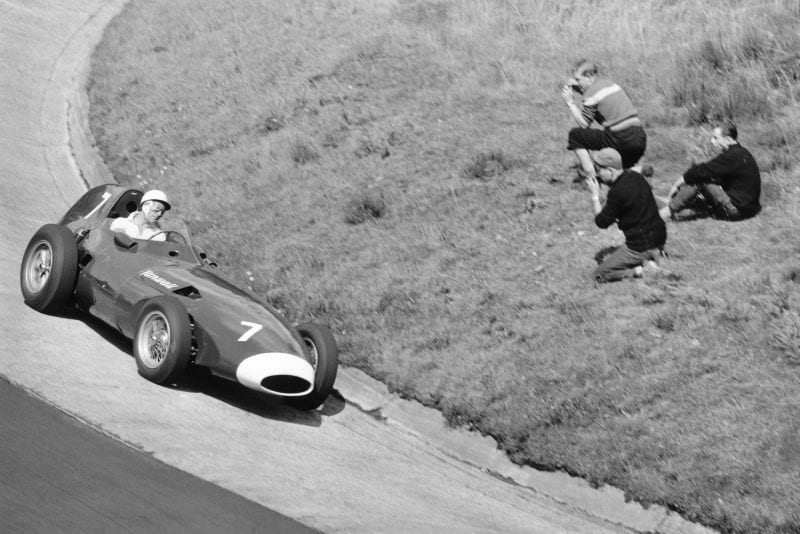
Stirling Moss takes his Vanwall around the Karussel.
Motorsport Images
At long last we got down to the comparatively serious business of the German Grand Prix and, though the starting grid was as shown below, there was a certain amount of nonsense because Brabham, Herrmann, Bonnier, Ruttman, Graham Hill, Allison and Goethals did not complete the required minimum of six training laps, either due to not reading the regulations carefully or blowing up their engines, while Naylor failed to get his paperwork scrutineered properly and was also on the black list. It was finally allowed that these eight should start, but from the back of the grid, irrespective of practice times, which accounts for Brabham’s poor grid position, as well as Allison’s and Bonnier’s. In all 25 cars were assembled on the grid, Ruttman being a non-starter as his engine was irrepairable, though Bonnier’s car had only five good cylinders.
As the flag fell the two Vanwalls got away well and Schell came round the outside from the third row and joined in with the leaders as they went down to the Südkurve, and it was Moss who led the way round on lap one. At the back of the field there was a certain amount of jostling going on for the fast people like Bonnier, Brabham and Allison were trying to make up for their bad grid positioning. During this melee Brabham rammed Bonnier in the tail and the Cooper was badly bent, while the Maserati went on with a big crease in the back.
“Allison’s opening lap with the sleek Lotus and only 1,960cc engine was quite something, coming as he did from the last row on the starting grid”
Moss did his standing lap in 9min 26.6sec and was 6sec ahead of Hawthorn, who was closely followed by Collins, Brooks, von Trips, Schell and Behra, Allison and Salvadori in nose-to-tail formation. Allison’s opening lap with the sleek Lotus and only 1,960cc engine was quite something, coming as he did from the last row on the starting grid, and he had caught and passed Salvadori’s 2.2-litre Cooper, which proves something or other. Phil Hill was leading the Formula II cars by a great distance, and was, in fact, hanging on to the tail of the main group of Formula I cars; and behind him came McLaren, Burgess, de Beaufort, Barth and Bueb, as quick as that. Naylor stopped at his pit with a defective fuel pump and poor Brabham limped in long after everyone was well round their second lap, the Cooper too bent to continue in the race.
Moss was really on form, and so was the Vanwall, so that his second lap was a new lap record with a time of 9min 16.6sec, and he was now so far ahead of Hawthorn that as the Vanwall disappeared round the Nordkurve behind the pits, to set off on its third lap, the Ferrari was just rounding the Südkurve, and Collins was right behind Hawthorn. Already the field was strung out, Brooks being on his own in fourth place, and then came Schell, Behra and Allison scrapping for fifth, followed by Salvadori and von Trips, the Ferrari pulling into its pits suffering from no brakes; nothing could be done, so von Trips rejoined the race, to continue to drive without using the brakes and stopping the car on the gearbox.
There was no change among the Formula 2 cars, though both Trintignant and Herrmann were mixed up with them and having difficulty in getting out of the ruck and joining in with the Formula I event. Bonnier failed to appear, his engine –– which had been bodged-up –– failing on the descent down to Adenau. Having got clear of the pack, Moss was out to build up a substantial lead in the early laps, and on his third time round he pulled out all the stops and recorded a truly fantastic lap record with a time of 9min 09.2sec.
Regardless of all circuit changes and progress in the Vanwall development, this was a truly meritorious effort and it put him 17sec ahead of the Ferrari pair, who came by this time with Collins leading and with Brooks still within striking distance. These four had left the rest of the runners way behind, and then came Behra, who was in a thoroughly bad temper at not being able to shake off the “fairground racers” of Allison and Salvadori. On this lap Gibson dropped out, de Beaufort stopped to change a front wheel on his sports Porsche, and Seidel stopped to see if there was anything wrong with the Rob Walker Cooper as he kept spinning round: there was nothing wrong, apart from the driver being hopelessly cramped in a cockpit designed around Moss and Trintignant, so he went on.
On the fourth lap there was a big dropout of cars, and the race was barely begun, for Moss coasted to rest at the Schwalbenschwanz with his magneto refusing to emit any more sparks, and with a truly remarkable lead over everyone else he had to stand by the roadside and watch Hawthorn, Collins, Brooks and the rest go by. The two Ferraris roared by the pits to start their fifth lap with a very good lead over Brooks in third place and next came a close trio consisting of Schell sandwiched between Allison and Salvadori.
“Behra came into the pits long after all the Formula 2 cars had gone by and retired with “driver boredom” as a change from the usual ‘mechanical boredom’”
Phil Hill was now seventh overall, and leading the Formula 2 class by an immense distance, and then came von Trips coasting into all the corners, followed by Trintignant who had at last got away from all the small cars. Herrmann failed to appear, his Maserati engine having blown up, and de Beaufort did not come round, while Behra came into the pits long after all the Formula 2 cars had gone by and retired with “driver boredom” as a change from the usual “mechanical boredom”. Goethals also gave up on this lap, the only difference this making to the race being that Seidel was now last.
The situation looked like Silverstone all over again, with the two Ferraris in full command of the situation and as Collins led Hawthorn by a length at the end of the fifth lap they had over 22sec lead on Brooks in the lone Vanwall, and their pace was such that the rest of the runners might have been in a different event. The Formula II Ferrari was going splendidly, apart from having inadequate brakes for its speed, or so it seemed to the driver, and behind it came Trintignant and von Trips, the German driver knowing very well that his brakes were inadequate. The Cooper/Lotus Formula I battle was still in the favour of Hornsey, while Surbiton had the advantage in Formula II, in both cases behind Ferrari cars one should add.
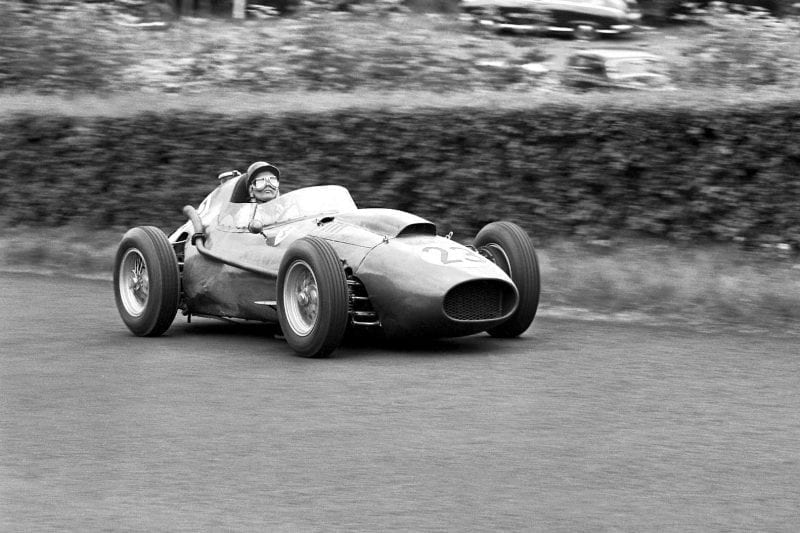
Phil Hill in his Ferrari Dino 156
Motorsport Images
Graham Hill went out with an oil pipe leak on the 1500cc Lotus projectile and on the next lap Phil Hill found himself spinning downhill towards Adenau on a hidden oil patch, though whether from the Lotus or not it is difficult to say. The F2 Ferrari took in some grass banks and finished up going the right way so Hill went on racing, still in the lead of the small car class, but now behind Trintignant and in eighth place overall. Meanwhile, up in front, the two Ferraris were playing games together, Collins leading across the line at the end of lap six and Hawthorn then taking the lead as they went past the pits.
It was now obvious that Brooks was no longer 22sec behind, he was decidedly closer and he did his seventh lap in 9min 16.7sec, which brought him visibly closer to the two Ferraris and on the next lap he was with them, passing on the twisty bits but being overtaken on the fast bits, the Maranello cars having more steam than the Vanwall. This was really stirring things up and it seemed a hopeless task for Brooks to do battle against the two Ferraris, but he kept at it and actually forced his way past Hawthorn and into second place as he went into the Nordkurve, making the Ferrari run wide. Once again he got by Collins only to be passed again on the straight, but this time he was alongside Hawthorn as they ended the tenth lap, and the Vanwall took the Ferrari as they went into the Südkurve and caught the leading Ferrari as they went into the Nordkurve.
Brooks had done his tenth lap in 9min 10.6sec, not as fast as Moss but an excellent time, and now having got the lead at the beginning of the twisty bits he was able to pull away. This wonderful effort by Brooks completely overshadowed the Formula 2 group, in which Hill was in dire trouble with the Ferrari, for when he went off the road he wiped away an engine breather pipe that runs under the tail of the car and was now pumping out oil mist onto his own back tyres, and was finding himself going sideways on all the corners, with the result that McLaren and Barth were catching him. Allison and Salvadori finally disposed of the second BRM when Schell had to retire with no front brakes, the ratchet adjusters having broken, and Seidel also gave up, for what it was worth.
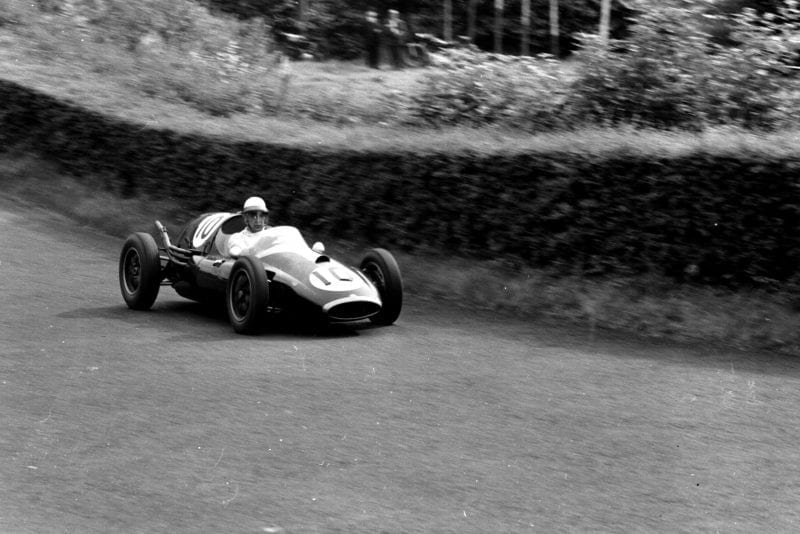
Roy Salvadori driving a Cooper T45 Climax
Motorsprot Images
On lap 11 disaster struck the Ferrari team, for rounding the double right-band curve after Pflanzgarten Collins was in his usual opposite-lock slide when he overcooked it and went off the road in full view of his team-mate, and while striving to catch the flying Brooks. Collins was taken to hospital with severe head injuries from which he later died and Hawthorn was left to carry on the struggle, but by the end of that lap his clutch began to show signs of failing and as the Ferrari went up the return road behind the pits it suddenly slowed and though Hawthorn continued on lap 12 he did not reappear.
This little scrap that ended so tragically had been motor racing at its best and the three of them had completely outpaced the remainder of the runners so that when Brooks went by on his own at the end of the 12th lap he was nearly 3min ahead of Salvadori, who was in second position, the Lotus having run into trouble.
“On lap 11 disaster struck the Ferrari team”
At the end of lap 11 Allison had drawn into the pits with a split radiator, no doubt a result of the practice crash achieved by his team-mate, and after a long time attempting to stop up the leak he continued, but now in last place. McLaren was driving remarkably well on his first visit to the Nürburgring and was leading Barth comfortably, the two of them passing the unhappy Phil Hill, and meanwhile Bueb, Burgess and Marsh had been doing some typical Brands Hatch wheel to wheel dicing for lap after lap, and in urging each other along they caught up with the leaders of their group so that Hill found himself surrounded by green Formula 2 cars which he could pass on the straight but which sailed past him on the corners.
At the end of lap 13, when Brooks was 3min 5sec ahead of Salvadori, with Trintignant third, von Trips a remarkable fourth still driving without brakes, and Mclaren leading the “tiddlers,” Bueb stopped at his pit to complain of failing oil pressure. While his mechanic was looking into the oil tank to see if the fluid was circulating there was a plop from under the car and a pipe split wide open and gushed oil all over the pit area, so Bueb retired after having had a good race. It was now all over and Brooks merely had to reel off the remaining two laps to win his second Grand Prix this season and put Vanwall back on the map.
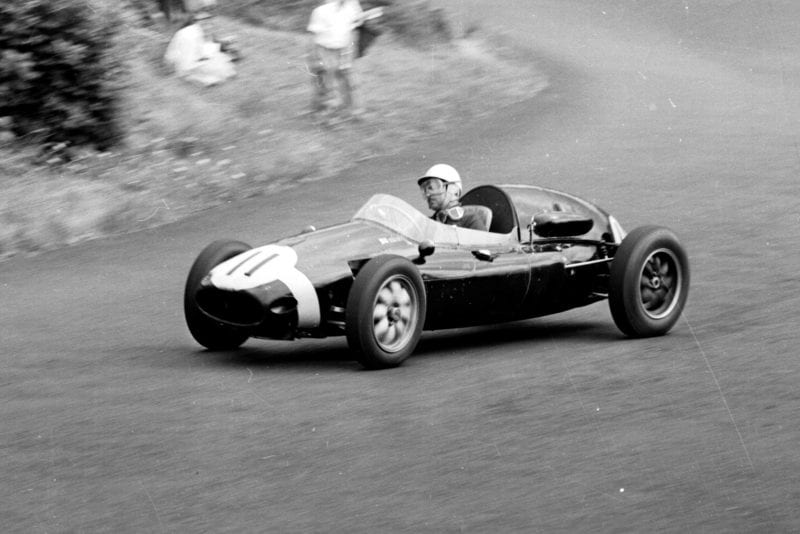
Maurice Trintignant in his Cooper T45 Climax
Motorsport Images
Nürburgring natters
- The death of Peter Collins was as unexpected as it was unfortunate, coming at a time when it seemed that he had got the business of being a professional racing driver more under control than most. Collins with his cheerful grin and happy nature will be missed by everyone.
- Vanwalls certainly made no mistakes this year, with two cars entered they collected first place with one and a record lap with the other.
- Afterwards Behra ruefully regretted having given up due to temperament; had he kept going he would have been third for sure and possibly second. A race is never lost until the flag falls.
- Two up and coming drivers who were outstanding on their first visit to the Nürburgring were Allison and McLaren. A pity that the Lotus split its radiator, for it would have been second and given Colin Chapman a much needed fillip. Had Allison finished third in the sports car race instead of retiring with a broken radius arm, Hornsey would have really been on the map in International racing.
- It should have been Brabham’s turn to drive the big Cooper but the organisers insisted that Salvadori should drive it, hinting that Brabham was not well enough known. This niggled Brabham and could have accounted for his staggering practice laps, which put his team-mate to shame. However, unlike some more powerful Grand Prix teams there is still a happy-family atmosphere at Surbiton.
Notes on the cars at Nürburgring
The Scuderia Ferrari had three identical Dino 246 cars, all with the Formula 1 chassis frame, one having forged top wishbones at the front, the others having welded tubular wishbones top and bottom. All three were using Houdaille shock-absorbers and had adjusters for spring tension on the tops of the front coil springs. The Formula 2 car, or Dino 156, was identical in layout, but had the lighter chassis frame with small diameter bottom rails; it also had in practice ribbed alloy front brake drums but these were changed for the regular turbo-finned cast iron drums for the race.
The fifth car was an experimental one built for the Monza 500 and driven there by Phil Hill. It was basically a Dino 246 model, but had telescopic front shock-absorbers mounted within the coil springs and coil springs at the rear in place of the usual transverse leaf-spring, these coils being interspersed between the de Dion tube and an extension to the top frame members. On this car the oil tank was moved from the tail to a position on the left of the scuttle, and in consequence the bodywork was more bulbous and the tail was a different shape, the whole car looking more like a Super Squalo of a few years ago than the current Dino cars.
The Vanwalls both had wire wheels on the front and alloy wheels on the rear, and the car Brooks drove had a new de Dion tube that kept the wheels parallel to each other instead of the usual positive-camber angle. Both cars used in the race had steering dampers and bracing struts to the tops of the kingpins. Improvements in handling were effected by juggling with a combination of springs, shock-absorbers, tyre pressures, and anti-roll bars.
The BRM team had three 1958 cars, one car having its chassis bent by Behra in practice. The two cars used in the race had external air intakes on the bonnets to feed the carburetters and one had the original oil system modification with a cooler an the right of the engine and the other had the later type mounted on the left with an air pipe feeding from the nose intake.
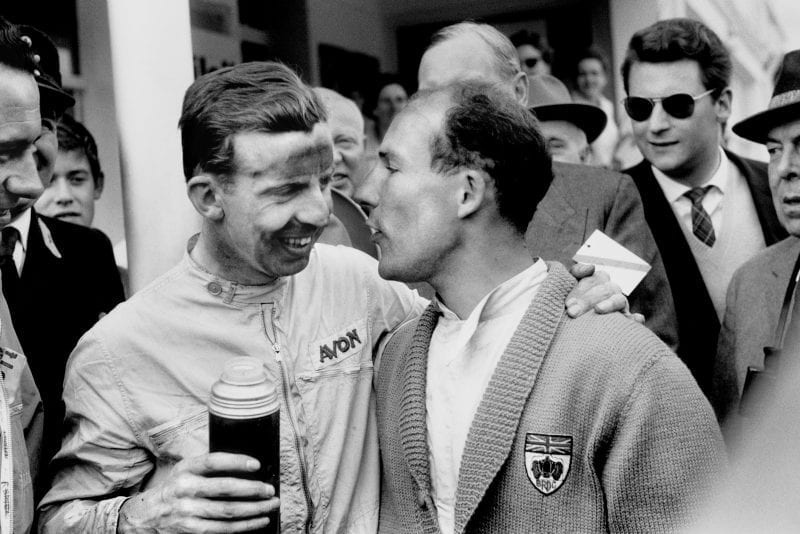
Winner Tony Brooks drinks from a flask with Vanwall team mate Stirling Moss who retired from the race.
Motorsport Images
Lotus had their two 1958 cars, the 1,960cc engine one driven by Allison having the gearbox/differential assembly mounted at an angle to the centre-line of the car so that the prop-shaft ran across the floor of the cockpit to the engine which was canted to the left 17 deg. from the vertical. The exhaust pipes on this car fed into part of the body structure, being completely concealed from view, and opening under the right side of the car exuding the gases just forwards of the rear wheel.
On this car all three pedals were hung from a central pivot point, the clutch and brake pedals diverging sideways from the pivot to each side of the bell-housing. On the 1,500cc car the gearbox/differential unit was mounted on the chassis centre-line so that the line of the prop-shaft, set to the left by the layout of the gearbox, ran forwards parallel with the chassis alongside the drivers left leg. Where it left the selector housing of the gearbox it then turned inwards across the floor of the cockpit to the back of the engine, this unit also being canted to left 17deg from the vertical. On this car the exhaust pipes were external and only the brake pedal was pendant, the clutch pedal being mounted down by the bell-housing. Eventually it is hoped to incorporate ideas from both layouts in the final version of the 1958 Lotus single-seater.
John Cooper is more than satisfied with the layout of his cars, both Formula 1 and Formula 2 models remaining virtually unaltered, and results indicate the advantages of a stable design. Trintignant drove the 1958 car with 2.2-litre engine that Moss had used to win with at Caen last month, while Seidel drove the old 1957 car with which Trintignant had won at Clermont-Ferrand the week before.
